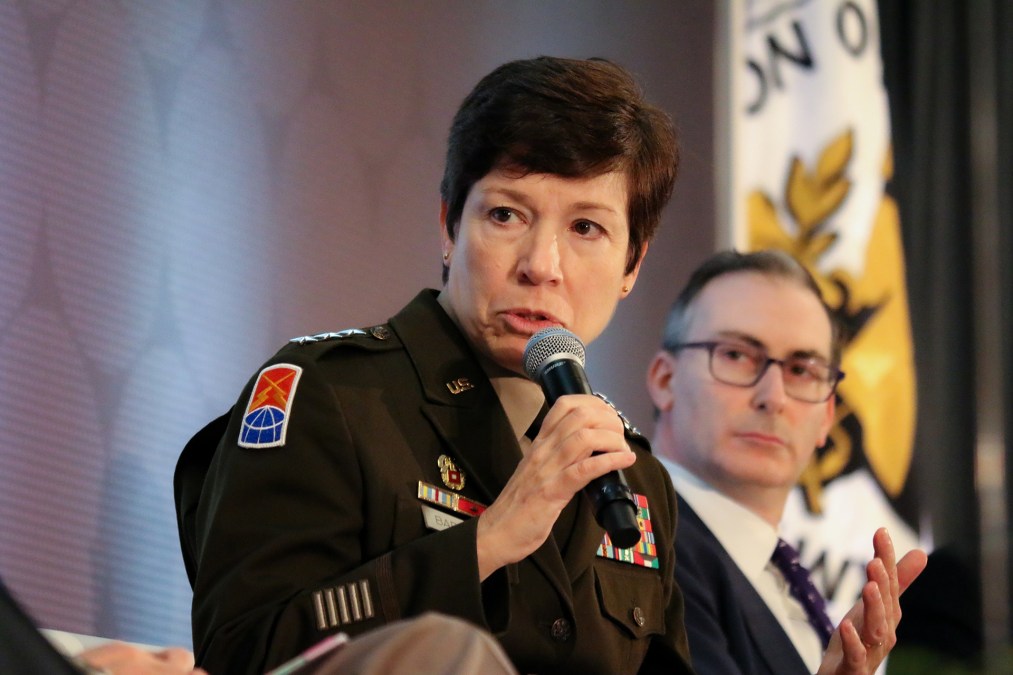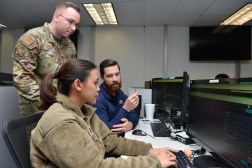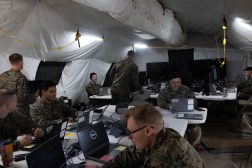What does setting the theater look like for Army Cyber Command?

One of the top priorities for Army Cyber Command’s leader is what she calls setting the theater for the command.
This an unfamiliar concept for the command because, as Lt. Gen. Maria Barrett puts it, “we don’t really have a theater, the globe is our theater.”
Barrett, who has been in command for about nine months, wanted to define what it means for Army Cyber Command to set the theater, which is complicated by the fact that its theater is global and it is executing missions every day.
“The idea of setting the theater … it’s not like a normal Army unit that thinks about the units that are deploying from [the continental U.S.] forward into theater and then, putting them to where their wartime fighting positions are and how they do sustainment from CONUS,” Barrett told DefenseScoop in an interview. “We don’t do that type of necessarily force projection. We also have to think about the fact that we do all of our operations – operate, defend, attack, influence and inform – we do them every day here in what we would call a period of competition.”
On a daily basis, against adversaries that seek to undermine the U.S. below the threshold of armed conflict, Army Cyber is responsible for protecting the Army’s portion of the network around the globe from cyber threats while also performing a variety of electromagnetic spectrum operations, information operations and offensive cyber operations for select combatant commands.
If deterrence fails or a situation escalates, Army Cyber must be ready to pivot in crisis and conflict, Barrett said, adding this is where the command is looking at evolving how it supports others.
In the case of pivoting to crisis, Barrett provided an example in the run up to the Russian invasion of Ukraine where Army Cyber sent forces forward to U.S. Army Europe and Africa to provide subject matter expertise in electronic warfare, information operations, defensive cyber and offensive cyber.
“We do feel like there’s a need to send folks forward at that point to accelerate things … until we can build that expertise resident in a particular theater,” she said.
Specifically, she was referring to expeditionary cyber and electromagnetic activities teams, or ECTs, the Army sent to Europe.
These teams – which are part of the 11th Cyber Battalion, formerly the 915th Cyber Warfare Battalion – provide cyber, electronic warfare and information operations planning and operations. They are scalable and will maneuver with units and conduct operations on the ground for commanders. The Army has laid out plans to have a total of 12 ECTs by 2026.
These teams performed mostly electronic protect functions, she said regarding the teams sent to Europe. However, depending on the situation in the future, there could be planners and operators capable of electronic warfare functions and information operations.
The Army is still shaping the exact concept and makeup of these forces and is using exercises and real world events to inform them.
“Whether you’re talking about either the planners or execution level forces, each one of these, whether we’re deploying them, we take advantage of every exercise and every real world event that we can to inform concepts of employment. It reinforces or validates which skills we need on a team, which ones we don’t think we actually need,” she said.
A new triad
Army Cyber has also recently joined with other globally focused Army units to develop a new concept it has dubbed the triad, harkening to the nuclear triad.
This new concept is a partnership between Army Cyber Command, Army Special Operations Command and Army Space and Missile Defense Command to combine their unique capabilities and deliver more options to commanders in an integrated fashion. All three are globally focused commands and they seek to fuse their capabilities to contest adversary activity occurring on a daily basis and help the military see farther — and faster — than America’s enemies.
Barrett was sure to note that the effort isn’t focused on building something right now, but to rather “first deliver the outcomes of combining our unique capabilities and people together and then determine if there’s build … because I don’t think we’re far enough along to say this is exactly what needs to be built.”
While there isn’t necessarily a desired end state in mind at the moment, Barrett said they’re focused on synchronizing and converging each organization’s capabilities to create an effect.
The way all three commanders have talked about the triad is “combining our unique capabilities and efforts to facilitate the use of these capabilities with either combatant commanders or their service commanders in the theaters,” Barrett said. “It is about how we take the unique capabilities and people that we have to do upfront planning on behalf of combatant commanders and provide them options that maybe they would not have considered previously because it was really hard to access or understand the capabilities of” each.
Highlighting the benefit this new triad concept could provide, Barrett recalled an example during a speech last year where she asked the audience if they’d ever been on a combatant command planning staff and they were enthusiastic about writing a concept brought to them to combine capabilities from Army Space and Missile Defense Command, Army Special Operations Command and Army Cyber, all of which are derived from three different sets of authorities.
“The audience predictably laughed and that told me what I needed to know. No, nobody wants to put together something that’s super complex and I have to go to three different entities to get the authorities to execute this,” she said. “But if we, on our own, understanding our unique capabilities and authorities can put that together in advance for a commander and offer that up as an option, that is a better way to go to accelerate this idea of combining these types of effects.”
Given they each have a global reach and mission, it allows them to also look at things in a more holistic way.
“We might look at things a little bit more broadly or innovatively than perhaps, somebody, a planner in a theater might look at them,” Barrett said, adding they also have a lot of interagency coordination as well.






